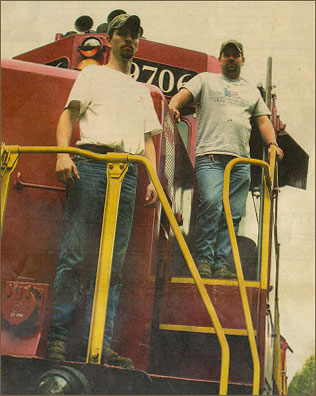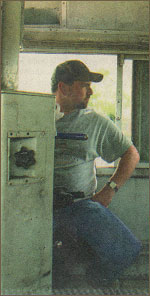Men of the Iron Road
 Brakeman Corey Childers, left, and Engineer Lamar Rutledge pause for a moment to look over the 70-foot trestle over Little River.
Brakeman Corey Childers, left, and Engineer Lamar Rutledge pause for a moment to look over the 70-foot trestle over Little River.
It sits quietly in the dark next to the Canton-Cherokee Business and Industrial Park, an iron beast idle as the shifts change and workers scurry to their jobs. And just as the first hint of gray light filters through the cloudy morning, two men come to wake the beast up.
It only takes about 10 minutes to warm the three diesel engines that power the Georgia Northeastern's local train from Canton to Marietta. While Engineer Lamar Rutledge warms up the engines and starts building air pressure for the brakes, Brakeman Corey Childers checks the brakes visually, walking the entire length of the train on both sides, insuring everything is ready for the trip south.
As Childers makes his way south along the train, he reads off the serial numbers of each of the eight railcars of marble in the train. After checking all of the railcars, the train begins its journey towards Marietta at about. 10 miles per hour. The train follows along the Etowah River until it comes upon its first crossing near downtown Canton. Scattered along the mostly wooded tracks are railroad timbers from previous repairs of the tracks.
Eleven-year railroad veteran Rutledge watches the tracks attentively, making little adjustments to the controls, which are essentially a throttle and an air brake lever. The little adjustments serve two purposes: to keep the speed of the train around 10 mph and to keep the kill switch from activating. The kill switch monitors the controls to make sure the engineer is awake and alive. If there is no movement on the controls for a brief period of time, it starts beeping. If the switch is not reset, it will shut off the train.
"That way, if the engineer were to ever fall asleep or have a heart attack, the train will not keep going," Rutledge said.
The Georgia Northeastern runs the Canton to Marietta train, called the "A.M. Local" or the "Lo" Monday through Friday, leaving Canton around 7 am., making several stops along the way to pick up or drop off railcars for Pilgram's Pride, Pacesetter Steel and other industries in Cherokee County. Some of the cars are dropped off along the way, but others make their way to the yard in Marietta, where the Georgia Northeastern line meets the main CSX line from Atlanta to Chattanooga.
 BOTTOM: The A.M. Local cruises through downtown Woodstock at 9.7 mph as cars stop at the crossing.
BOTTOM: The A.M. Local cruises through downtown Woodstock at 9.7 mph as cars stop at the crossing.
"We run five days a week, sometimes six if there is a high demand," Rutledge said.
In Marietta, the train picks up railcars for its customers and hauls them back towards Canton, making stops as needed along the way. By about 3 p.m., the train is back in Canton and the next crew, called the "1500" takes the train on to Tate, which is about as far as the train runs these days. From there the P.M. Local loads the car up with marble and it is hauled back to Canton, Where it waits for Rutledge and Childers. Occasionally, the line will run further up the tracks to Ellijay and even as far as Blue Ridge, where the Blue Ridge Scenic Railway takes passengers on to McCaysville.
By 8 am., the train is picking up its first load of additional seven cars from Pacesetter Steel, which are on a sidetrack, weighing in at 868 tons of sheet steel. Once Rutledge pulls forward of the sidetrack, Childers rolls the cars on to the main line, using gravity and then the brakes of the cars to bring them to a stop. Rutledge then backs the train to connect with the new cars and then resumes the trip south past Holly Springs and on to Toonigh.
It sprinkles a little, just wetting the tracks, but not enough for Rutledge to worry about. When the rails get especially slick, the engineer has jets that blast sand on to the tracks, which improves traction.
At 8:27 a.m., the train crosses Univeter Road and picks up a defective railcar from Pilgram's Pride in the Toonigh area and heads south towards Woodstock, crossing over a 70-foot trestle, arriving in Woodstock at 9:42 a.m.
The train, with more than 3,000 tons of cargo, is bearing down, at 9.7 mph, on one of the most dangerous crossings it has: a major road with no crossing guards. A white van cuts across the tracks after the signal goes on and Rutledge and Childers just shake their heads. They see it all the time. A few days before, a truck carrying natural gas cut across the tracks.
"Even at 10 mph, it takes a while to stop the train," Rutledge said. "The train always wins in an accident. That is why we always have the right of way."
 Rutledge watches the tracks as the train makes its way northward towards Canton.
Rutledge watches the tracks as the train makes its way northward towards Canton.
By 10:00 am., the train has arrived at Pacesetter Steel's distribution center in Marietta along Canton Road. But before they can drop the steel off at the facility, they have to pick up the two empty cars on the center's spur line and place them on a sidetrack further south.
This will take some "cutting," where the brakeman and the engineer will disengage and add railcars in sequence from the rest of the train and wrangle them back and forth along the tracks.
Cutting involves planning and a clear mental picture of what needs to go where. It also involves close communication between the brakeman and the engineer through two-way radios.
"It is like putting together a puzzle," Childers said. "You cut the train in a way that allows you to move the cars back and forth easily."
Childers' voice crackles over the radio, letting Rutledge know how far he has to go to forward or back. They keep track of distance in terms of the length of a railcar, about 50 feet.
Rutledge has his hand on the throttle the whole time, easing off just as he is about make a connection. If he connects to another car too fast, it can cause damage.
They pull forward of the sidetrack, blocking a crossing, stop, than back up. Rutledge knows it drives the folks in the cars nuts, but there is nothing he can do.
"I am sure they are looking at us, pulling forward, stopping, backing up and wondering what the heck we are doing," Rutledge said. "I have had people walk up to me and tell me what they think of me blocking the intersection. I understand their frustration and we try to be as quick as possible."
They drop off two more cars for the facility to offload, then haul away the empty cars and bring in two more, and then resume the trip south, the whole stop taking about 50 minutes of jostling the cars back and forth on the tracks.
From there, it is straight to the yard, a connecting point for the Georgia Northeastern line and the CSX line that runs northwest from Atlanta to Chattanooga.
They reach the yard near Church Street in Marietta, disengage the cars and pick up the northbound load. Most of the cars are empty cars for Pilgram's Pride, Georgia Marble and Pacesetter Steel. The train can haul between six and seven full cars per engine and four empty cars equals a full car.
"Ever since gas prices went up, we have been really busy," Rutledge said.
By 12:35 p.m they are heading back north with a few loads of corn and soybeans for Pilgram's Pride and a load of lumber for a Marietta lumberyard, as well as a number of empty cars. The ride north is uneventful until they reach Univeter Road at about 2:07 p.m., where they once again have to cut the train numerous times to shuffle the empty cars to a sidetrack and drop off the full cars for the plant, but it only takes about 20 minutes of shuffling for these cars.
With 22 cars left, they head north again to the Canton-Cherokee Business and Industrial Park.
By 2:55, they have locked down the train and are ready to head home. The 3 p.m. crew, the "1500," will take it on to Tate. But after a 46-mile round trip, the A.M. Local on the Georgia Northeastern Railroad is done for the day.
Copyright © Grant Sinclair 2005
Header image of GNRR 9706 courtesy of Kyle Yunker © 2016
The milepost visible in the header image dates from the Louisville & Nashville period, and gives the distance in miles from Louisville.
Additional GNRR information
The Georgia Northeastern Railroad starts at Elizabeth, GA, where it connects with the Western & Atlantic Sub of CSX (the same line that is infamous for The Great Locomotive Chase back in the Civil War). It then runs for about 22 miles to Canton, GA, then on to Tate, GA, where the GNRR workshops are.
From there the rail line (basically unused as of 2020) runs from Tate to Blue Ridge, which is where the Blue Ridge Scenic Railroad starts (motive power and maintenance are by GNRR). From there it goes to McCaysville, GA/Copperhill, TN where it ties in with the Copperhill Scenic line. That line (managed by the Tennessee Valley Railroad Museum) runs from Etowah to Copperhill, then ties back in with the Tennessee Valley Railroad Museum in Chattanooga, TN.
This whole line was at one time owned by the Louisville & Nashville, who bought out the Atlanta, Knoxville and Northern Railroad, who bought out the Marietta and North Georgia Railroad, who bought out the Marietta, Canton and Ellijay Railroad, who bought out the Ellijay Railroad, which was started in 1854.
Adapted from a post in the forum by Hawk.